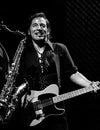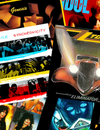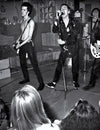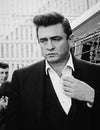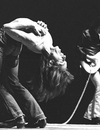
Outlaw Country: The Stories that made the Outlaw Country Movement
Every cultural movement experiences rebellion within it. The country music industry of the 1970s was no exception. The controlled, formulaic, stale production of the “Nashville sound” wasn’t working for a group of country artists who decided enough was enough and walked away from their post at the assembly line of the Nashville music factory to explore other avenues of production. The result was the creation of the outlaw movement and outlaw country music.
While the exact origin of the “outlaw country” label is disputed, it was two Texans who are widely accepted as being the pioneers of the movement: Waylon Jennings and Willie Nelson.
In 1965, Jennings moved to Nashville to record an album with RCA Records. Willie had warned him that Nashville wasn’t the place to be if he was looking to be free of corporate rules when producing his music as he had become frustrated with the situation there. Jennings would soon find that out. Waylon moved in with Johnny Cash, and fueled by amphetamines, the two began a lifelong friendship and the environment of control by the commercial labels was soon shaken.
The Fuel
Jennings became sick of the “Nashville establishment machine” and the rules it forced upon the musician's creative output. The Grand Ole Opry was part of the machine, dictating how artists were to act and look, and what music they could play. He said:
"They wouldn't let you do anything. You had to dress a certain way; you had to do everything a certain way. They kept trying to destroy me. I just went about my business and did things my way. You start messing with my music, I get mean."
The “Nashville sound” trend was about to be subverted. Inspired by previous outlaws like Bob Wills, Hank Williams, Elvis Presley, and Buddy Holly, their music harkened back to the blues, honky-tonk, and rockabilly roots of the 1940s and 50s after Jennings and Nelson were able to secure control of their recording rights. In 1972, Waylon renewed his contract with RCA, but only after he was granted full artistic control over his music. Nelson left RCA and signed with Atlantic Records in 1973 in order to gain control of his future work.
They were now free to grow long hair, wear leather instead of rhinestones, and speak openly about being part of the drug culture. It was around this time that the term “outlaw country” was being thrown around. Some attribute the term to the song (and album) ‘Ladies Love Outlaws,’ performed by Jennings and Lee Clayton in 1972. Art critic Dave Hickey suggested in a 1974 article in Country Music magazine that the term was simply used to describe artists that opposed the Nashville content mill. Others have claimed that the term simply cemented itself into the culture over a period of years. Regardless, the 1976 compilation album titled ‘Wanted! The Outlaws’ solidified the term and the movement by becoming the first country album to be certified platinum by selling a million records. It featured songs by Waylon Jennings, Willie Nelson, Jessi Colter, and Tompall Glaser.

The Outlaws
The members of the outlaw group spread far and wide, of course. Southern rock was now starting to influence the music of many of the country-western stars and the movement grew. The most successful of the group are recognizable names: Waylon, Willie, Kris Kristofferson, Merle Haggard, David Allan Coe, Johnny Cash, Hank Williams Jr, and Steve Earle. Many of the now legendary stories of drinking, partying, and bucking the system should also be familiar. However, they started long before "outlaw country" was a recognizable term.
The Texas Troubadour
Ernest Tubb - known as “The Texas Troubadour” - was an artist who laid the groundwork for the above-mentioned in the 1950s, both musically and in their social lives. In 1957, loaded drunk, Tubb walked into the National Life building in Nashville with a .357 magnum with the intention of shooting producer Jim Denny, who had fired Hank Williams from the Grand Ole Opry. Denny wasn’t there, but he fired his gun toward a bystander. He missed, luckily, and was charged with public drunkenness.
No-Show Jones
George Jones was notorious for his love of drinking and cocaine. He beat his wife, Tammy Wynette, shot at his friend, and developed the nickname “No Show Jones,” as he was a no-show at many of his gigs. Wynette has said:
“When he’s drinking, he turns completely into a madman. He likes to play with guns and he would shoot guns in the middle of the night. He shot the tiles off the bathroom walls.”
A memorable quote from Jones: “If you’re going to sing a country song, you’ve got to have lived it yourself.”
It Started In San Quentin
In 1957, at 20 years old, Merle Haggard was convicted of attempted armed robbery of a tavern in Bakersfield, California. He was sentenced to fifteen years at San Quentin Prison. It was there that he saw Johnny Cash perform the second of his now-famous prison album recordings. Haggard served three years and started recording immediately after his release. He soon was listed on the country music charts with the "Bakersfield sound" that he and others developed.
The Man In Black
Johnny Cash spent years fighting his demons. Drinking, drugs, and women almost ended him. By 1967, he’d crashed. From his autobiography:
“I was taking amphetamines by the handful...I was canceling shows and recording dates, and when I did manage to show up, I couldn’t sing because my throat was too dried out from the pills… I was in and out of jails, hospitals, car wrecks. I was a walking vision of death and that’s exactly how I felt. I was scraping the filthy bottom of the barrel of life.”
He laid in a cave by the Tennessee River one day to “let God take (him) from this earth.” He walked out of the cave and vowed to change his life.
Hollywood
When Kris Kristofferson decided to pursue a music career over a life of military service his family - who served in the military - disowned him. He decided he needed to do something to garner the attention that would justify his choice, so he landed a helicopter on Johnny Cash’s front lawn. Cash recorded ‘Sunday Morning Comin’ Down,’ and Kristofferson’s career took off and he’s gone on to star in Hollywood movies. Kris won a Golden Globe for his role in the 1976 version of ‘A Star is Born,’ which co-starred Barbra Streisand
Hoss
Waylon Jennings' twenty-year drug habit began when Johnny Cash moved in with him in Nashville in 1965. The DEA showed up at the studio where he was recording, and he had enough cocaine to be arrested as a trafficker. By the time they came back with a search warrant, the drugs were long gone. For the track ‘Don’t You Think This Outlaw Bit’s Done Got Outta Hand?’ he included the lyrics:
They came pounding through the back door in the middle of the song
They got me for possession of something that was gone, long gone.
When Jennings started playing at rock bars, he’d let everyone know that he was going to play country music and add:
“..and we sure hope you like it. But if you don’t like it, you’d better keep your mouth shut, ’cause we will kick your ass.”
Shotgun Willie
Given the nickname “Shotgun Willie,” Nelson once shot at his daughter’s abusive husband:
“I ran for my truck and drove to the place where Steve and Lana lived and slapped Steve around. He really pissed me off. I told him if he ever laid a hand on Lana again, I would come back and drown his ass. No sooner did I get back [home] than here came Steve in his car, shooting at the house with a .22 rifle. I was standing in the door of the barn and a bullet tore up the wood two feet from my head. I grabbed an M-1 rifle and shot at Steve’s car. Steve made one pass and took off."
Nelson’s road manager recalls Willie ending a shootout in a parking garage after a show in Birmingham, Alabama in the late 70s:
“And here comes Willie. He walks off the bus wearing cutoffs and tennis shoes, and he’s got two huge Colt .45 revolvers stuck in his waist. The barrels are so long they stick out the bottom of his cutoffs. Two shining motherfucking pistols in plain sight of a bunch of cops nervous as shit. Willie just walks over and says, ‘What’s the trouble?’ Well he’s got some kind of aura to him that just cools everything out. The cops put up their guns, the people climb off the concrete, and pretty soon Willie is signing autographs.”
And, maybe the most brazen Willie story of all: he smoked a joint in the White House with then-President Jimmy Carter’s son, Chip.
Willie said: “We were there, and there it was, and why not, you know? And they have a great view from the roof."
Guitar Town
Steve Earle once threw a plate of food in the face of a record executive who was trying to dictate the cover art on his next album. Said Earle:
“I don’t have a problem with authority, authority has a problem with me. Nobody even considers for one second trying to tell me how to do it.”
VP at MCA Nashville Tony Brown recalls: “He took his plate and flipped his steak at me…and then he called me a couple of names I won’t repeat.”
Years later, Earle added: “Exit 0’s still in print. Go pick one up and see what the cover is.” In the 90s, Steve lost everything he owned to pay for a heroin addiction that nearly killed him. All he had was his house: “I lost everything but my house,” he said in 2017. “I guess it’s because I couldn’t figure out how to put it in the car and take it to the pawn shop.”
Rebel Meets Rebel
David Allan Coe went to prison in 1967, at the ripe age of 20, for robbery and grand theft auto. There is also a story floating around the internet that he killed an inmate who made sexual advances toward him. Journalists refuted the story. He’s a retired member of the Outlaw Motorcycle Club. He was a member of the Louisville, Kentucky chapter but was also known to ride with outlaw bikers in Dayton, Florida. He even rode his motorcycle up on stage while Waylon Jennings was singing and started singing with him, and Willie Nelson came out to join them. Coe joined forces with members of Pantera to record ‘Rebel Meets Rebel’; an album that was released in 2006.
Hank Jr.
In 1975, Hank came very close to dying, falling several hundred feet down a Montana mountainside. He endured multiple reconstructive surgeries on his face and skull. Returning to perform in 1976, he appeared as he does today, sporting a beard and, long before it became fashionable again for country singers, a cowboy hat. Though outspoken about politics - he compared Barack Obama to Hitler - and homophobic - he screamed gay slurs at people in public - he was elected into the Country Music Hall of Fame in August 2020.


















